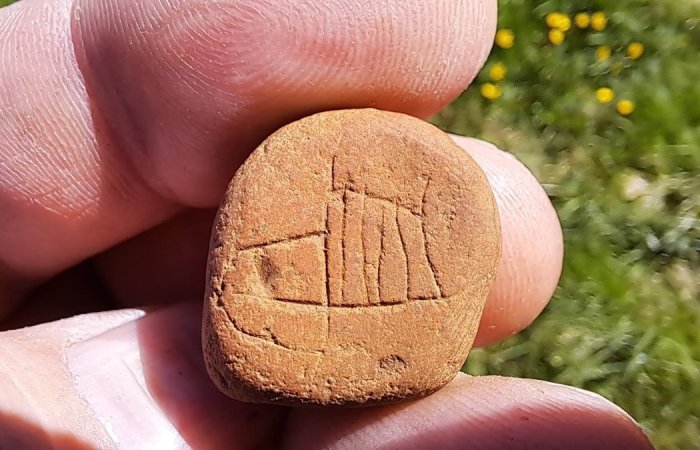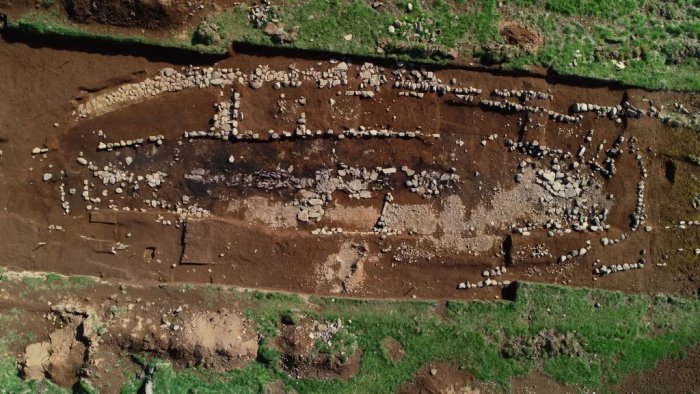Jan Bartek – AncientPages.com – Archaeologists excavating site Stöð on Stöðvarfjörður in East Iceland have found a small stone carved with a Viking Ship. This little find may be a big archaeological discovery as it seems this is the oldest picture ever found in Iceland.
The stone was discovered inside a longhouse that is believed to predate the permanent settlement of the island.

A small sandstone with a carved Viking ship may be the oldest picture ever found in Icleand. Credit: Facebook – The Landnámsskáli group in Stöð
“Bjarni F. Einarsson, the archaeologist leading the excavation, says that the stone was found in the wall of the older cabin. Such carvings of ships are quite common in the Nordic countries, carved in bone, wood, or stone. This is the first drawing of a ship that he knows of that has been found in Iceland and must be the oldest drawing in the country,” RÚV reports.
Archaeologists have been excavating at Stöð since 2015, and during this time, they have found a large number of intriguing artifacts and relics. In recent years, the focus has been on investigating the settlement-era longhouse.
“The longhouse is among the largest found in Iceland, 31.4m [103ft] long. In Scandinavia, only chieftains’ farms had longhouses larger than 28m [92ft]. It is also the richest longhouse ever excavated in Iceland. We have found 92 beads and 29 silver objects, including Roman and Middle Eastern coins,” Bjarni F. Einarsson told Iceland Review.
“What makes the site still more significant is that archaeologists discovered an even older longhouse underneath the settlement-era longhouse, estimated to date back to around 800 AD, some 75 years before the permanent settlement of Iceland. The most striking feature of the older structure is the conspicuous absence of the bones of domesticated animals,” the Icelandic Review reports.

One of the longhouses found at the site. Credit: Bjarni Einarsson
“My theory is that the older longhouse was a seasonal hunting camp, operated by a Norwegian chief who outfitted voyages to Iceland to gather valuables and bring them back across the sea to Norway,” Bjarni told Iceland Review. One of these valuables may have been walrus ivory: in 2019, DNA analyses and radiocarbon dating confirmed that Iceland was previously inhabited by a North Atlantic subspecies of walrus, now extinct.
An interesting subject is that Vikings often burned and buried their longhouses.
Architecture takes on special importance as a collective expression of the organization and mindset of a culture, and people had a special relationship to their houses.
Marianne Hem Eriksen, a postdoc at the Department of Archaeology, Conservation, and History at the University of Oslo has studied the custom of how Vikings burned and buried their iron Age longhouses.
According to Eriksen, Vikings saw a link between the human body and the house. This suggested that the house borrowed many features from the human body. It’s very possible that Vikings believe the house had some kind of essence, some kind of soul, and this was the reason why they wanted to give their house a proper burial.
Of course, not all longhouses were buried or burned. The fact some survived gives archaeologists a better opportunity to find artifacts and relics.
See also: More Archaeology News
A large area around Stöð has been investigated by archaeologists who found traces of unknown ancient structures and boat burial sites. Much about this Icelandic settlement is still unknown, but based on the discovery of beads, coins, and silver, it would seem this was a trading place where wealthy people met and lived. More excavations will provide answers about the settlement.
Written by Jan Bartek – AncientPages.com Staff Writer





